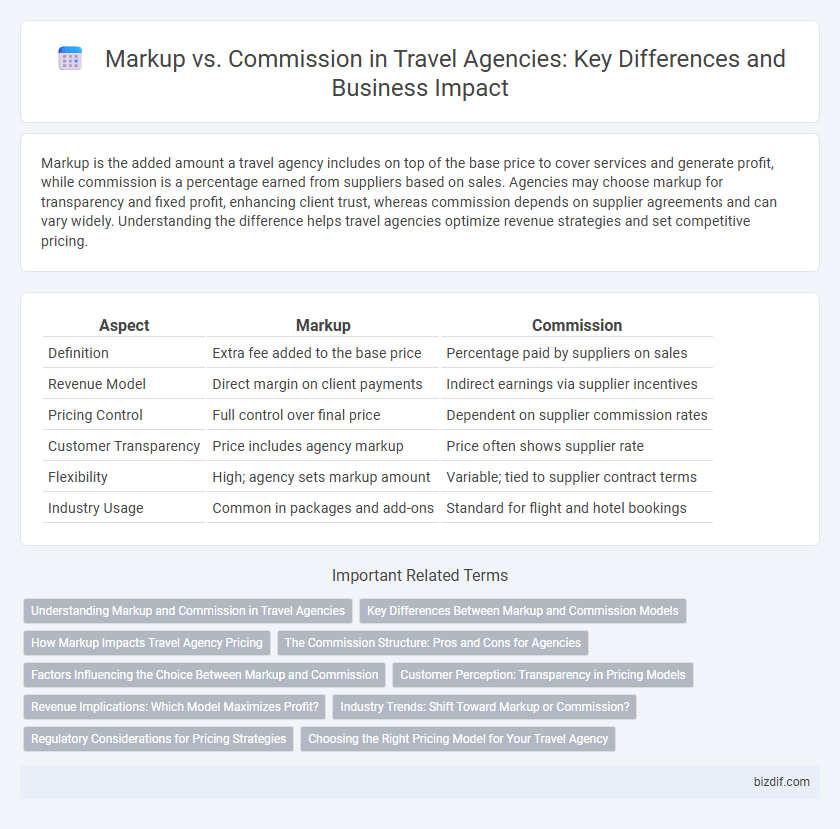Markup is the added amount a travel agency includes on top of the base price to cover services and generate profit, while commission is a percentage earned from suppliers based on sales. Agencies may choose markup for transparency and fixed profit, enhancing client trust, whereas commission depends on supplier agreements and can vary widely. Understanding the difference helps travel agencies optimize revenue strategies and set competitive pricing.
Table of Comparison
| Aspect | Markup | Commission |
|---|---|---|
| Definition | Extra fee added to the base price | Percentage paid by suppliers on sales |
| Revenue Model | Direct margin on client payments | Indirect earnings via supplier incentives |
| Pricing Control | Full control over final price | Dependent on supplier commission rates |
| Customer Transparency | Price includes agency markup | Price often shows supplier rate |
| Flexibility | High; agency sets markup amount | Variable; tied to supplier contract terms |
| Industry Usage | Common in packages and add-ons | Standard for flight and hotel bookings |
Understanding Markup and Commission in Travel Agencies
Travel agencies often determine their earnings through markup or commission models, where markup involves adding a fixed percentage or amount to the wholesale price of travel products such as flights, hotels, or tour packages. Commission, on the other hand, is a percentage of the sale price paid by suppliers like airlines or hotels to the agency for booking their services. Understanding the differences between markup and commission helps travel agencies optimize pricing strategies, maximize revenue, and maintain transparency with clients.
Key Differences Between Markup and Commission Models
Markup involves adding a fixed percentage or amount to the cost price of travel services, allowing agencies to set transparent prices for customers. Commission is a percentage of the sale paid by suppliers to travel agencies, incentivizing bookings without altering the advertised price. Unlike markup, commission depends on supplier agreements and does not directly affect the consumer's final price.
How Markup Impacts Travel Agency Pricing
Markup directly influences travel agency pricing by allowing agencies to set their own profit margins above the wholesale cost of travel services. This strategy provides flexibility in pricing packages, enabling agencies to adjust rates based on demand, seasonality, and competition. Unlike commissions, which are fixed percentages from suppliers, markups give agencies greater control over revenue and profit optimization.
The Commission Structure: Pros and Cons for Agencies
The commission structure enables travel agencies to earn a percentage of the total booking value, incentivizing volume sales and fostering strong supplier relationships. Agencies benefit from predictable income streams but may face limitations in pricing flexibility that can impact profit margins. Relying heavily on commissions can also reduce transparency for clients, potentially affecting trust in agency recommendations.
Factors Influencing the Choice Between Markup and Commission
Travel agencies choose between markup and commission based on factors like supplier relationships, pricing transparency, and client expectations. Agencies with strong supplier partnerships often prefer commissions for steady income, while those emphasizing customized pricing favor markup to control profit margins. Market competitiveness and service complexity also play critical roles in determining the optimal revenue model.
Customer Perception: Transparency in Pricing Models
Transparent pricing models enhance customer trust by clearly distinguishing between markup and commission in travel agency fees. Customers often perceive markups as additional charges directly increasing the price, while commissions are viewed as indirect earnings from providers, influencing perceived fairness. Emphasizing transparency in these pricing structures improves satisfaction and reduces confusion regarding the true cost of travel services.
Revenue Implications: Which Model Maximizes Profit?
Markup involves adding a fixed percentage to the base cost of travel services, directly increasing revenue per transaction while maintaining transparent pricing for customers. Commission relies on earning a percentage from suppliers, which can fluctuate based on sales volume and supplier agreements, potentially leading to variable income streams. Choosing between markup and commission models depends on client demographics, supplier relationships, and pricing strategies to maximize overall profit margins in a travel agency.
Industry Trends: Shift Toward Markup or Commission?
Travel agencies are increasingly shifting from traditional commission-based revenue models to markup pricing strategies, responding to changing supplier policies and consumer demand for transparent pricing. Market data shows a growing trend where agencies apply markups on net rates to enhance profit margins and maintain pricing control amid fluctuating industry costs. This shift aligns with digital booking platforms' influence, pushing agencies to adopt flexible pricing models that prioritize customer trust and operational agility.
Regulatory Considerations for Pricing Strategies
Travel agencies must navigate regulatory considerations when choosing between markup and commission pricing strategies to ensure compliance with fair trade and consumer protection laws. Transparency requirements often mandate clear disclosure of fees, impacting how markups are applied and commissions are reported. Failure to adhere to regulations, such as the Federal Trade Commission (FTC) guidelines in the U.S. or similar entities globally, can result in legal penalties and loss of consumer trust.
Choosing the Right Pricing Model for Your Travel Agency
Choosing the right pricing model for your travel agency involves understanding the key differences between markup and commission structures. Markup allows agencies to add a set percentage to the base cost, providing transparent pricing and greater control over profit margins. Commission-based pricing relies on earning a percentage from suppliers, which can incentivize volume sales but may limit pricing flexibility and transparency.
Markup vs Commission Infographic

 bizdif.com
bizdif.com